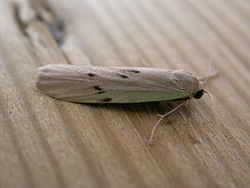| Pelosia muscerda | |
|---|---|
 | |
| Scientific classification | |
| Kingdom: | Animalia |
| Phylum: | Arthropoda |
| Class: | Insecta |
| Order: | Lepidoptera |
| Superfamily: | Noctuoidea |
| Family: | Erebidae |
| Subfamily: | Arctiinae |
| Genus: | Pelosia |
| Species: | P. muscerda |
| Binomial name | |
| Pelosia muscerda (Hufnagel, 1766) | |
Pelosia muscerda, the dotted footman, is a moth of the family Erebidae. The species was first described by Johann Siegfried Hufnagel in 1766. It is found in the Palearctic realm.

The wingspan is 24–28 mm. The moth flies from June to September depending on the location.